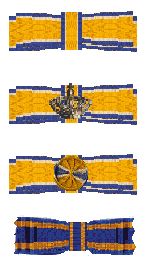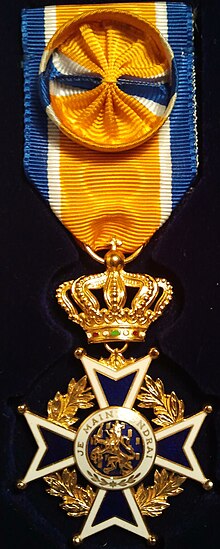Order of Orange-Nassau
The Order of Orange-Nassau ( Dutch : Orde van Oranje-Nassau ) is a Dutch order of merit based on the model of the Luxembourg Order of the Oak Crown , which is awarded by the incumbent monarch to people with special merits for society and the community. Foreign nationals and Dutch nationals living abroad can also be awarded the medal, provided that their services are directly related to the Netherlands. The order was founded on April 4, 1892 and has comprised six classes since 1996.
Dutch civil order
The Netherlands has two civil orders of merit - called loosely lintje (ribbon) in Dutch - which were created to honor the merits of people towards society. These are the Orde van de Nederlandse Leeuw ( Order of the Dutch Lion ) and the Orde van Oranje-Nassau (Order of Orange-Nassau) discussed here .
history
The medal was first awarded in 1892. Grandmaster is always the King or Queen of the Netherlands. 1841 donated Willem II. , King of the Netherlands and in personal union Grand Duke of Luxembourg, the Order of the Oak Crown . Although it was a Luxembourg rather than a Dutch medal, it was given regularly to Dutch and foreign diplomats. When his son and successor Willem III. Wilhelmina died in 1890, succeeding the Dutch throne under the reign of her mother Emma . Because of the force in Luxembourg Salic Law , however, the Grand Duke dignity went to another line of the House of Nassau on: there followed the former Nassau Duke Adolf I . Luxembourg thus became an independent state.
As a result, the order could no longer be awarded by the Dutch head of state. It was therefore necessary to establish a new Dutch Order, which had the same target group as the Luxembourg Order of the Oak Crown. On April 4, 1892, Wilhelmina, represented by her mother Emma, donated the Orde van Oranje-Nassau .
Award
In 1994, after almost 30 years of fundamental discussion, the award system was comprehensively revised and newly regulated by law. The awards were first affected by the new regulation in 1996.
With the new version of the regulations, the legislature had in mind a democratic system of awards that should no longer leave room for preferences and automatisms. It should be simple and fair, and the manner of distinction should be separated from rank and social status. Not only people in management positions or from leading families, but also those who keep social institutions alive and make them accessible to the general public through their personal commitment should be taken into account. In principle, it should therefore be accessible to everyone who has made a lasting contribution to society.
Anyone can suggest who should be given a medal. Information brochures and forms are available in town halls and municipal offices, and advice is given on the terms and conditions of proposals. The Dutch embassy or diplomatic missions of the Netherlands are responsible for awarding foreigners, including foreign diplomats , and forward the recommendation to the Minister for Foreign Affairs. The statute of the Order of Orange-Nassau contains more detailed regulations.
An independent committee decides on the award of a royal award, which examines every suggestion and assesses the respective merits on the basis of the specified criteria and submits a recommendation to the responsible minister on this basis. The final decision on the award is made by the respective minister, usually the minister for foreign affairs.
Order classes
Until 1996, the order consisted of five classes and a medal of honor in three levels: gold , silver and bronze . Medal of Honor bearers were not accepted into the order. The medal of honor has not been awarded since 1996 and the order has been expanded to include a sixth class (member):
Order decoration
The medal is a white and blue enameled golden Maltese cross with golden beads on the cross tips, which hangs from a crown . In the middle of the cross there is a blue enamelled medallion with the Dutch lion, which is surrounded by a white enamelled ring with the golden inscription JE MAINTIENDRAI (I will insist / insist). On the back of the medallion a crowned W (Willem) with the inscription GOD ZIJ MET ONS (God be with us). There is a golden laurel wreath between the arms of the cross .
For military merit, the order is awarded without a laurel wreath, but with two crossed swords through the cross angles.
The ribbon on which the medal is worn is orange with a blue and a narrow white stripe on one side.
The execution of the order differs depending on the class. The higher the class, the bigger the medal and the wider the ribbon. The Grand Cross and Grand Officer classes also receive a breast star . The decorations of the knights and members are made of silver. There is also a women's version of each class.
With the award, a certificate is handed out, on which, in addition to the name, the date and file number of the royal decision in question are recorded.
Carrying method
When the medal is awarded, the recipient is put on the neck or infected and in future only worn on important occasions, i.e. at official receptions by the king and other invitations that are expressly requested, as well as on other occasions, for example on national holidays, when the Order is appropriate. Those who have more than one award must wear them in the order of the rank of the award.
For wearing in normal day clothes, there are “draagtken”, small pins for the Revert, or “draaglintjes”, buttonhole decorations.
Known porters
Knight's Grand Cross
→ Bearer of the Order of Orange-Nassau (Grand Cross)
Grand Officer
→ Bearer of the Order of Orange-Nassau (Grand Officer)
commander
→ Bearer of the Order of Orange-Nassau (Commander)
officer
→ Bearer of the Order of Orange-Nassau (officer)
Knight
→ Bearer of the Order of Orange-Nassau (Knight)



